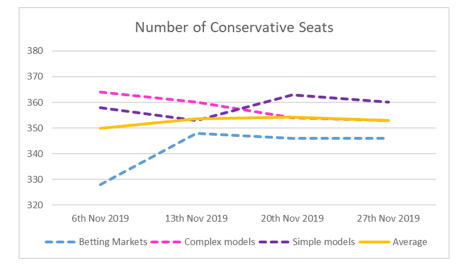By Stephen Fisher, John Kenny and Rosalind Shorrocks
There has not been much change in our combined forecast over the last week. The Conservatives are still apparently headed towards a comfortable majority (55 on average) based on an average forecast vote share lead over Labour of 12 points. The average predicted probability of a Tory majority has crept up to 72%, partly due to increasing confidence in the betting markets and the quantitative forecasting models, as well as the polls. Citizens remain much more sceptical. Concerns that the Liberal Democrats might make little advance continue, and were compounded by the Datapraxis MrP forecast of just 14 seats for the party. Otherwise the Datapraxis forecast was largely in line with other forecasts of headline seats totals. Further MrP based forecasts are due this week, including YouGov’s.
| Seats | Betting Markets | Complex models | Simple models | Average |
| Con | 346 | 353 | 360 | 353 |
| Lab | 210 | 212 | 204 | 209 |
| LD | 25 | 21 | 22 | 23 |
| Brexit | 0 | 0 | 0 | |
| Green | 1 | 1 | 1 | 1 |
| SNP | 45 | 45 | 43 | 44 |
| PC | 4 | 4 | 4 | 4 |
| Con majority | 42 | 55 | 69 | 55 |
 Continue reading Fourth combined forecast for the 2019 general election
Continue reading Fourth combined forecast for the 2019 general election



 Note: Due to an error in our 2ndJune 2017 betting market calculation (and no way of correcting it at this stage) the betting market line runs direct (interpolates) from 26thMay to the final 8thJune 2017 estimate.
Note: Due to an error in our 2ndJune 2017 betting market calculation (and no way of correcting it at this stage) the betting market line runs direct (interpolates) from 26thMay to the final 8thJune 2017 estimate.